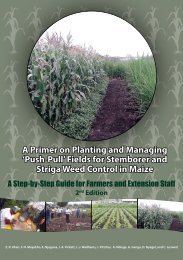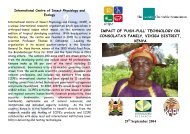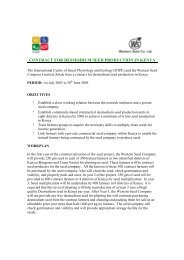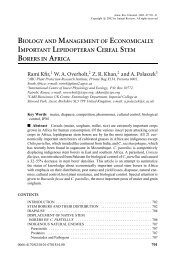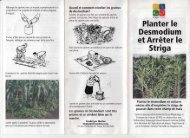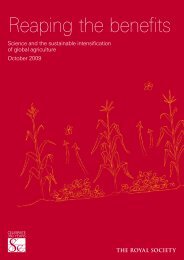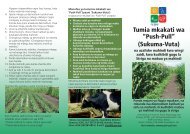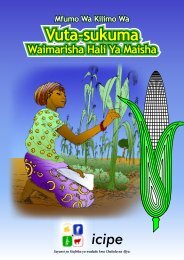a model for Africa's green revolution - Push-Pull
a model for Africa's green revolution - Push-Pull
a model for Africa's green revolution - Push-Pull
Create successful ePaper yourself
Turn your PDF publications into a flip-book with our unique Google optimized e-Paper software.
Uptake and impact: knowledge is the key 7<br />
2. Uptake and impact:<br />
knowledge is the key<br />
In early 1997, Khan and his colleagues began<br />
disseminating the push–pull or habitat management<br />
technology to farmers, aiming to transfer<br />
both the technology and the knowledge of<br />
how it worked. Training in scientific methods<br />
encouraged farmers to experiment further, gain<br />
ownership of the technology and pass on their<br />
new knowledge to others. By training a network<br />
of farmer–teachers, helping establish farmers'<br />
groups, and facilitating farmer field schools and<br />
field days, the team have established a mechanism<br />
<strong>for</strong> rapid adoption, which is the key to widespread<br />
impact. Over 40,000 farmers have now<br />
adopted the technology (see graph) and most of<br />
them can relate stories of major upturns in their<br />
<strong>for</strong>tunes and living standards.<br />
Seeing is believing<br />
Although the researchers could explain the<br />
technology with confidence, they soon discovered<br />
that farmers remained highly sceptical unless they<br />
could see a push–pull plot <strong>for</strong> themselves. The first<br />
step, then, was to establish a push–pull garden at<br />
Mbita Point, which farmers and others could visit.<br />
Next, the researchers began to establish trial and<br />
demonstration plots on selected farmers’ fields.<br />
The push-pull garden at icipe’s Thomas Odhiambo<br />
Campus at Mbita Point, Kenya<br />
Researchers from KARI and government extension<br />
staff helped identify suitable areas <strong>for</strong> on-farm<br />
trials. The team chose two districts <strong>for</strong> the initial<br />
trials: Suba, on the eastern shores of Lake Victoria,<br />
and Trans Nzoia, further north. In both areas, there<br />
is a high reliance on maize and a lack of food security.<br />
Livestock ownership is also widespread but<br />
good quality fodder is in short supply.<br />
Number of<br />
farmers<br />
45000<br />
Adoption of the push–pull<br />
technology in East Africa,<br />
1997–2010.<br />
40000<br />
35000<br />
30000<br />
40,620 farmers<br />
25000<br />
20000<br />
15000<br />
10000<br />
5000<br />
0<br />
1997<br />
1998<br />
1999<br />
2000<br />
2001<br />
2002<br />
2003<br />
2004<br />
2005<br />
2006<br />
2007<br />
2008<br />
2009<br />
2010<br />
Years



